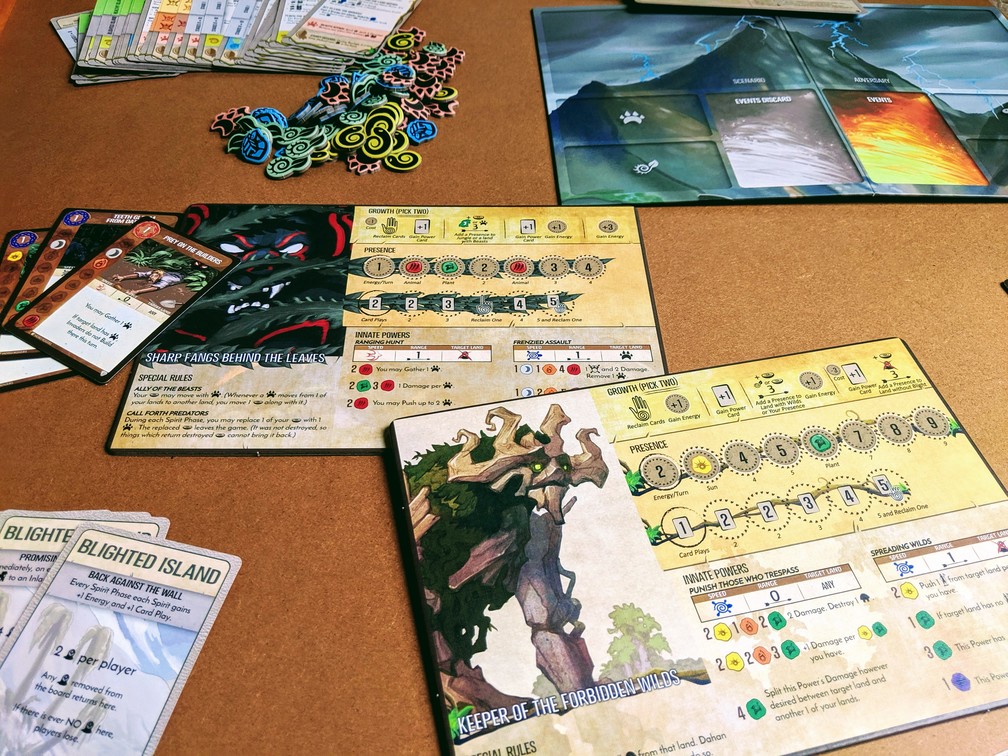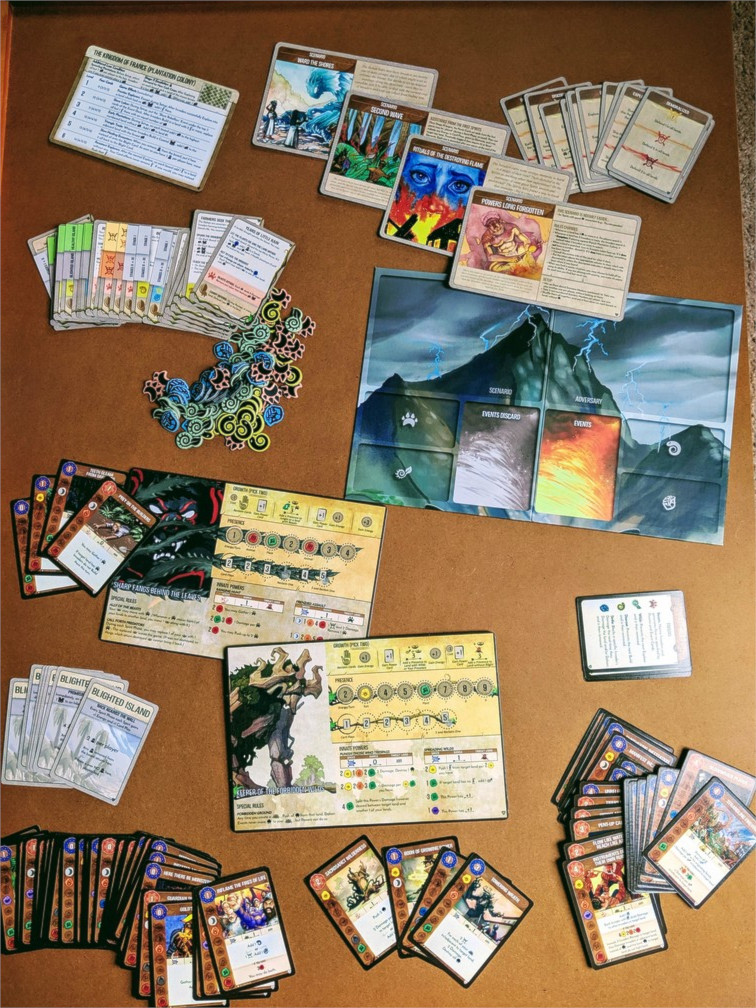“All right, we are up against the English. They build if they have buildings around the area.”
“Right. Which they always do. So any spirit against explorers is basically useless.”
“Yes. So there goes Shadows Flicker Like Flame. And this new guy, Keeper of the Forbidden Wilds, he spreads wilds, but we don’t really care about stopping exploring either.”
“Right. Bringer of Dreams and Nightmares does not destroy anything, and we need destroys. So he is also out.”
“Vital Strength of the Earth?”
“Hm. Too defendy, I don’t know. We need damage.”
“Like Thunderspeaker.”
“Not really, I mean, their buildings have plus 1 health, so direct damage is not as good as simply destroying buildings.”
“Well that could be said about the other new guy, Sharp Fangs Behind the Leaves.”
“Yeah, but he also spreads beasts, and that is very useful with the events. I would keep him in the loop.”
“All right. I think the others are good, they either have direct building destroying powers, (Ocean’s Hungry Grasp, Lightning’s Swift Strike, and River Surges in Sunlight), or can defend against builds (A Spread of Rampant Green).”
“So we have 5 spirits. That only leaves us with 10 options.”
“OK. I’ll take Ocean because I like the blue.”
“And I’ll make an executive decision and take one at random.”
“Great. Almost ready to actually start playing the game!”
Branch and Claw is the first official expansion to Spirit Island. Obviously, the experience is similar to the base game, so everything that we said for the base game still stands with the expansion. But what does it add to the core gameplay?
Well, one clue hidden in plain sight is the two new spirits, both of moderate difficulty. One is a tree guy and the other is like a beast, and together, they are Branch and Claw. Get it?

The most significant change in the game is the addition of events. Every turn in the invader phase, you draw a random event card. Usually, there is a big story choice with a cheap but detrimental, and an expensive but advantageous outcome to the island, and several other little effects, like the Dahans growing in numbers, or beasts prowling in the area.
Another game mechanic introduced is four different tokens, which if placed on the board, harm the invaders in various ways. You can grow the wilds, preventing exploration in a land, spread disease, so those pesky invaders don’t build, or you can… put down a strife token, which weakens them during the next ravage. There are also beasts as I mentioned above, the effect of which is much less predictable, they might be beasting, depending on the event cards.
And, last but not least, there is more of everything. There are new scenarios, an adversary, additional minor powers, major powers, fear, and blighted island cards. The whole game got much bigger and much more replayable.
The Good
Well, it’s mostly more of the good stuff, more variability, events are particularly making the game more unpredictable and fun.
The four tokens are a natural addition to the game, thematically and mechanically as well, they make sense and it feels like they should have always been there. (Partly because the base game already mentioned them, so on the one hand it is a product designed well in advance, on the other hand I always have a weird feeling by this level of marketing in a game.)

The two new spirits work great, it’s nice to finally have an early game bully in the roster. The beast spirit can only work efficiently in non-blighted lands, of which there are fewer and fewer. One of the new spirits uses the beasts, the other the wilds, making you use the new token functionality more.
And naturally, everything that is good in Spirit Island is good here too. We had a bit of trouble classifying the base game as a gamer’s game, it was right on the edge, but we were not sure if it really cut it. However, with this expansion, we are 100% sure, this is a pure gamer’s game experience, complexity and difficulty alike.
The Bad
The two new spirits are great, yes, but I find it weird how there are no spirits focusing on disease or strife, so those two new tokens are kinda not really there in the game, unless you draw a specialized power card. It would make perfect sense thematically to have at least a disease spirit, instead of the multiple spirit incarnations of the same concepts – there are multiple water and tree spirits.
I generally like the event cards, however, they do add a significant amount of luck to the game. In the base game, most of the unpredictability came from not knowing where the invaders are going to explore next. It feels like the volatility really skyrocketed. Which is fine, and I like it, but the completionist in me now has to constantly wonder if we really did beat that adversary on level 6, or did we just get lucky with the cards? Although the more and more we play, the less relevant the luck seems, but it’s definitely there.
I also do not like how 1/3rd of the event cards is about the beast tokens, but unless you pick the beast person, there won’t be many beasts going around. It feels like it’s a balancing item for that particular spirit, but that somehow does not feel right. The power of all the other spirits come from their own cards and innate abilities, so it’s weird to enhance one particular spirit’s power level with random event cards.
My colleague also did not extensively rave about this in the base game review, let me just put it here: the game is ugly as hell. Most of the pieces look somehow wrong and cheap, with the exception of the Dahan, those wooden huts are cool. That system where the buildings are put on their sides and on their other sides to keep track of the amount of damage they have taken was stupid to begin with, and the introduction of adversaries where the buildings have higher than standard hitpoints further emphasized the flaws in this system. But the main issue is the artwork on the pictures. Oh mama. There are really cool illustrations, yes, capturing the mysticism and pagan tone of the game. But there are also ones which could easily have been created during an afternoon drawing session in any regular kindergarten. And it’s not even like some artists were talented, and the others obviously took a wrong career choice, there are huge quality differences in pictures created by the same persons.
The lack of any consistent design philosophy makes the game look vibrant, chaotic, and colourful, true, but I can also proudly present Spirit Island to be the ugliest game I have ever owned. Which is a title that did not even exist before Spirit Island.

And finally, the big complaint. The game gets really complex with the tokens and events, and there is always a lot going on. Remember, there are the base game rules, and then literally any rule can be overriden by the following impacts:
- adversary;
- scenario;
- fear card(s);
- event card(s);
- token(s) placed on the land;
- any power card / innate ability played this turn;
- any combination of the above.
And it is getting hard to keep everything in mind. I usually don’t mind that in a nicely built and elegant system, but Spirit Island is not that.
Let me give you an example. In the new event cards, there are sometimes events that have different effects, based on where you are in the invader deck (stage I, II, or III). And in the expansion rulebook, there is a section that explains how if you are drawing one of these cards AND also playing against Brandenburg – Prussia, you will have to do something differently. It makes sense, and it’s logical, but it made me think of two things: 1): I will definitely forget it, if the time ever comes, and 2): if they really had to add this rule, what else could they be missing. And you might think, how difficult it is to keep something like that in mind, well, imagine that it’s more like twenty similarly arbitrary-looking little things.
It could be just me, I have a background that could generally be described as mathematical, and all these rule exceptions and overrides and clauses and little nuances and the utter lack of a robust system really makes me feel like I’m trying to understand a legal book. It won’t make me not love the game, but it’s definitely a badly visible stain on the otherwise almost spotless record.
The Co-Op
Co-op is perfect in this game. Similarly to the core, you have to very efficiently communicate with your partner(s). You simply cannot understand all the details of what the other is going to do, but you do have to have the gist of it in order to make your decisions. Especially on higher difficulties, finding the right spirit combos is a very satisfying process on its own.
The Recommendation
Oh, yes. If you are intrigued by complex games, definitely get Spirit Island: Branch and Claw. It adds a ton to the core gameplay, increases difficulty in my opinion, and creates a bunch of additional viable strategies you can try.
Info
| Release Year | 2017 |
| Genre | Strategy |
| Difficulty | Extreme |
| Number of Players | 1 to 4 |
| Length | 2 - 3 hours |
Rating
| Overall | Great |
| Story | Good |
| Co-Operation | Great |